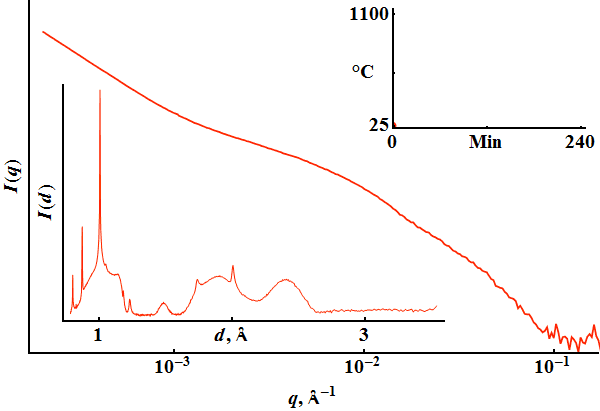Summary
This project develops and applies metrologies and standards for characterizing microstructure and dynamics in advanced functional materials of technological importance, including heterogeneous or porous materials, over multiple length scales in situ and operando.
Description

In operando ultra-small-angle X-ray scattering (USAXS), small-angle X-ay scattering (SAXS), and wide-angle X-ray scattering (WAXS) measurements of the precipitate evolution (from USAXS & SAXS) and simultaneous phase evolution (from WAXS) in an advanced nickel-based superalloy heated over 4 hours to 1100 °C. All features can be quantitatively analyzed.
Click on image to see simultaneous time evolution of small-angle X-ray scattering (precipitate morphology) and X-ray diffraction (phase composition) as function of temperature and time.
New technologies increasingly harness materials phenomena that operate across many length-scales: e.g., in selective gas adsorption, additive manufacturing, new alloy designs, or advanced concretes. To overcome technology barriers, it is no longer sufficient just to characterize the materials. Rather, these multi-scale material processes must be measured and understood under operando conditions. .
The objective of this project is to develop metrologies and standards, provide rigorous structural, thermodynamic and kinetics data for operando multi-scale microstructure and dynamics measurement in advanced functional material systems, and support new and sustainable technologies not fully realized at the present time.
Major Accomplishments
Innovative in situ / operando X-ray & neutron scattering methods have elucidated a wide range of multi-scale processes in technological materials, with recent papers in CrystEngComm, Environmental Science & Technology, Dental Materials, Langmuir, Cement & Concrete Research, Journal of Alloys & Compounds, Journal of Applied Crystallography, Acta Materialia, Nanoscale Advances, Nanomaterials, Fuel,...
Major results have been obtained relevant to Additive Manufacturing processes for metals & alloys – especially in regard to the unexpected appearance of undesired deleterious phases during post-build stress-relief heat treatments in nickel-based super alloys, and also in regard to benchmark measurements for validating modeling and simulation predictions.
Structural & microstructural changes in both natural and advanced manufactured gas sorbents have been correlated with selective gas adsorption & desorption processes relevant to carbon mitigation, enhanced oil & gas recovery, & catalysis.
Our partnership with the APS at Argonne National Laboratory has resulted in the development of a world-leading synchrotron X-ray based materials measurement facility, allowing fully quantitative characterization over the angstrom to micrometer-scale range within a few minutes. Collaboration with both the APS and NCNR has produced enhanced experimental sample environments for both facilities.
A new NIST Standard Reference Material, SRM 3600, has been issued for the absolute intensity calibration of small-angle X-ray scattering intensity.
In situ and operando measurements of additive manufacturing (AM) processes have expanded to encompass ceramics AM, including post-build processes such as cold sintering, as well as AM of cement and concrete by exploiting the rheological properties of “ink pastes” during cement hydration.
In parallel with its other accomplishments, this partnership with the APS has enabled two unique complementary measurement paradigms to be developed:
The coherent component of the synchrotron X-ray beam has been exploited in combining the USAXS capabilities with X-ray photon correlation spectroscopy (XPCS). The USAXS/XPCS technique allows particle dynamics or changing local microstructural arrangements to be probed directly when other more conventional techniques are not sensitive.
The USAXS capabilities have also been combined with X-ray imaging to enable USAXS contrast imaging and USAXS tomography measurements to be developed. These methods enable heterogeneous features to be highlighted, compared to more conventional X-ray imaging techniques.
Development of all these methods to address both NIST mission objectives and the APS user program remains ongoing.
NIST SRM 3600 please see https://www-s.nist.gov/srmors/view_detail.cfm?srm=3600 .

